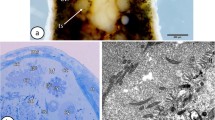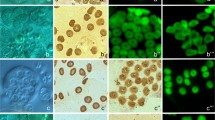Summary
A light microscopic and phase-contrast study of the developing seminiferous follicles in two elasmobranch species was made. After an initial period of independent mitotic divisions, each spermatogonium becomes entirely surrounded by a cytoplasmic extension of a single follicle cell (Sertoli cell). These bicellular units may be termed spermatocysts. This relationship remains through six succeeding germ cell generations, usually resulting in a group of 64 isogenous spermatids in each spermatocyst. Thus, all substances exchanged between the blood stream and the germ cells must pass through the body of the follicle cell. As the spermatids transform into spermatozoa, they are drawn into a compact bundle and are finally released from the follicle cell. Germ cell development is closely synchronous within each spermatocyst and spermatocyst development is synchronous within each follicle. Germ cell and Sertoli cell lines appear to be entirely separate. Intercellular cytoplasmic connections are retained among large groups of daughter germ cells. It is suggested that these cytoplasmic bridges as well as spermatocyst formation serve in promoting equality of physiological opportunity throughout the large germ-cell mass.
Similar content being viewed by others
Literature
Balbiani, G.: Leçons sur la génération des vertébrés. Paris: Octave Doin 1879.
Fawcett, D. W., S. Ito, and S. Slauttehback: The occurrence of intercellular bridges in groups of cells exhibiting synchronous differentiation. J. biophys. biochem. Cytol. 5, 453–460 (1959).
Fratini, L.: Osservazioni sulla spermatogenesi di Scyliorhinus canicula. Pubbl. Staz. zool. Napoli 24, 201–216 (1953).
Hermann, G.: Recherches sur la spermatogénèse chez les selaciéns. J. Anat. Physiol. 18, 373–432 (1882).
Jensen, O. S.: Recherches sur la spermatogénèse. Arch. Biol. (Paris) 4, 669–747 (1883).
La Valette St. George, A. J. H. von: De spermatosomatum evolutione in plagiostomis. Bonn 1878.
Matthews, L. H.: Reproduction in the basking shark, Cetorhinus maximus (Gunner). Phil. Trans. B 234, 247–316 (1950).
Roosen-Runge, E. C.: The process of spermatogenesis in mammals. Biol. Rev. 37, 343–377 (1962).
Sabatier, A.: Sur quelques points de la spermatogénèse chez les sélaciens. C. R. Acad. Sci. (Paris) 120, 47–50 (1895).
—: La spermatogénèse chez les poissons sélaciens. Trav. Inst. Zool. Univ. Montpellier, N. S., Mém. 4, 1–190 (1896).
Sanfelice, P.: Spermatogenesi dei Vertebrati. Boll. Soc. nat. Napoli, Ser. I, 2, 42–98 (1888).
Semper, C.: Das Urogenitalsystem der Plagiostoma. Arb. zool.-zoot. Inst. Würzburg 2, 195–509 (1875).
Stephan, P.: Sur le développement de la cellule de Sertoli chez les sélaciens. C. R. Soc. Biol. (Paris) 54, 773–775 (1902).
Swaen, A., and H. Masquelin: Etude sur la spermatogénèse. Arch. Biol. (Paris) 4, 749–801 1883).
Author information
Authors and Affiliations
Additional information
Postdoctoral Fellow from the Division of General Medical Sciences, U. S. Public Health Service. Supported in part by U. S. Public Health Service Training Grant 5 Tl GM-136, Department of Biological Structure, School of Medicine, University of Washington, Seattle, Washington, USA. — The author wishes to express his appreciation to Drs. Edward C. Roosen-Runge, John H. Luft and Daniel Szollosi of the Department of Biological Structure, University of Washington, for suggesting improvements in the manuscript. I am deeply grateful to Professor Giovanni Chieffi of the Zoological Station of Naples for his guidance and encouragement during this investigation.
Rights and permissions
About this article
Cite this article
Stanley, H.P. The structure and development of the seminiferous follicle in Scyliorhinus caniculus and Torpedo marmorata (Elasmobranchii). Zeitschrift für Zellforschung 75, 453–468 (1966). https://doi.org/10.1007/BF00336875
Received:
Issue Date:
DOI: https://doi.org/10.1007/BF00336875




